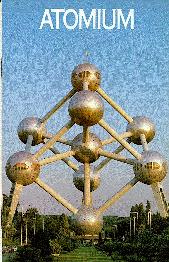
jkm@skypoint.com
This page was last updated on

I visited this unique structure in 1992. The following is shamelessly plagarized from a brochure on the structure:
Designed and built for the Brussels Universal and International Exhibition
1958 by the Belgian Metal Industries:
* Federation of the Metalworking Industries, "FABRIMETAL".
* Belgian Blast-Furnace and Steelworks Group.
* Union of Non-Ferrous Metals Industries.
|
The Universal Exhibition in Brussels in 1958 needed a spectacular structure
which would be a lasting symbol of this world-embracing event and which would
give Belgian industry the opportunity of displaying its capabilities.
The metal industries' trade associations promised the Commissioner for the 1958 Exhibition that they would help to provide this symbol and had already started working on it in the autumn of 1954. In November 1954, the engineer André Waterkeyn, who was a director at the Federation of the metalworking, mechanical and electrotechnical engineering industries, came up with the Atomium project. His idea was to reproduce the concept of the atom, which is at the heart of all the sciences concerned with the formation of matter, and to demonstrate by a monument the importance of everything that happens on an infinitesimal scale. To make his project a reality, André Waterkeyn decided to magnify 160 billion times the elementary iron crystal on the scale of its atoms. The construction he envisaged was composed of nine huge spheres, linked together by tubes in the configuration known as the centered cubic system. The choice of an iron crystal was natural enough for the metal industries which were to build the structure called by its creator the "Atomium". The project was submitted in December 1954 to the directors of the metal industries' trade associations and to the General Commissioner of the Exhibition. All of them approved it as the solution to their problem. The three industrial groups - the Federation of the metalworking, mechanical and electrotechnical engineering industries, the Belgian blast-furnace and steelworking group and the Union on non-ferrous metals industries - joined together in a non-profit-making organisation and appointed André Waterkeyn as its Managing Director assisted by M. E. Greiner. The team was completed by engineering consultants Beckers, Joukoff and Daniel, architects A. and J. Polak and Director F. Hébrant. A number of specialists were called in, too many to list here, and cooperated with great enthusiasm. Now the design and preparation work began. There were many problems to solve, but the team set to, to meet the deadline - the Exhibition's opening date. To avoid any misunderstanding: the Atomium was built by private enterprise, encouraged, it is true, by the authorities, but left entirely in the charge of its promoters, the three Belgian metal industry associations. Their basic objective was to give the 1958 Exhibition and the city of Brussels a grandiose and original structure which would be the symbol of the new technical disciplines that will shape the future. It is particularly pleasant to praise the exceptional efforts, made with enthusiasm and inspired by the will to succeed, of all those who worked on the project - the three promoter associations, the many companies which were involved in the studies and construction, the engineers, technicians and those outstanding teams of workmen whose difficult and often dangerous task was actually to build the "Atomium". The Atomium played its role perfectly for the Exhibition of 1958, so well, in fact, that the City of Brussels asked for it not to be dismantled afterwards. Since then, it has welcomed thousands of visitors and still keeps all of its significance. It does not represent, as some tend to think, the liberation of nuclear energy, but the marvellous organization of molecular structures on an infinitesimal scale, and the importance of past, present and future discoveries in this fascinating field. |

This page was last updated on